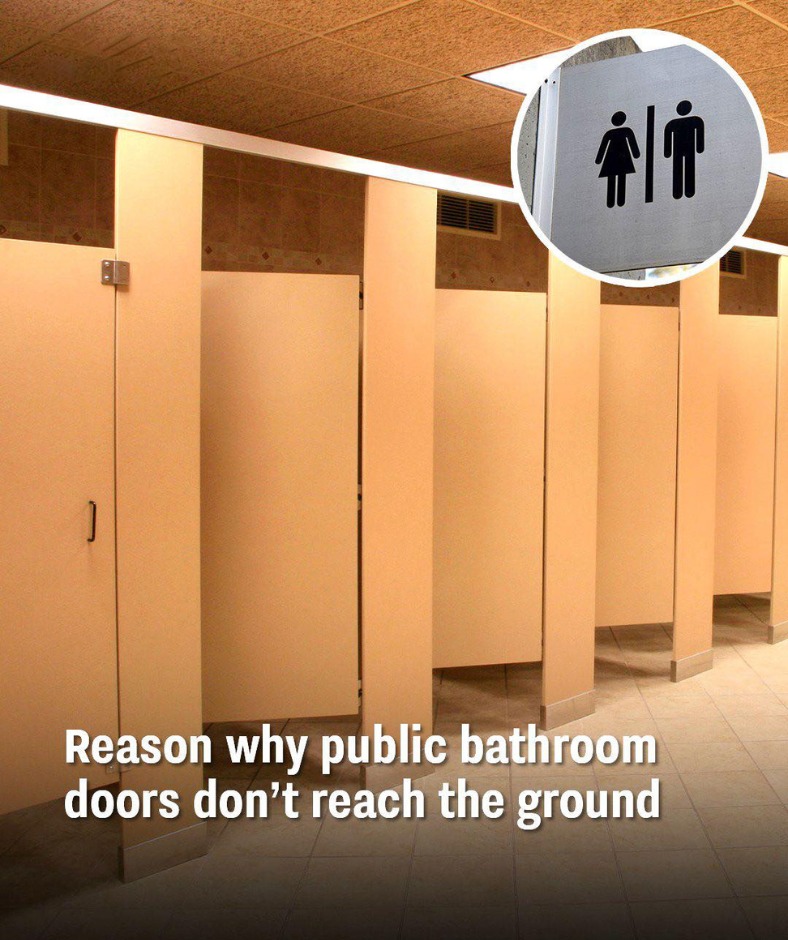Have you ever stopped to wonder why public restroom stall doors don’t extend all the way to the floor? It’s one of those details most people notice but rarely question. While it might seem like an odd design choice, this feature serves several practical purposes. Let’s dive into the thoughtful considerations behind this seemingly unconventional design, from emergency access to cost efficiency.

One of the most important reasons for the gap at the bottom of public restroom stall doors is emergency access. Imagine someone inside a stall experiencing a medical issue or other emergency. The open space allows others to quickly assess the situation and provide help if necessary. As TikTok user MattypStories aptly points out, “If there’s ever an emergency, it would be pretty easy to see what happened and get the person some help.” This practical feature prioritizes safety, ensuring that aid can be rendered swiftly without needing to force the door open.
Another major advantage of raised doors is easier cleaning. Public restrooms are high-traffic areas where cleanliness is crucial. With the gap at the bottom of the doors, custodians can clean the floors more efficiently. Mops, pressure washers, and other cleaning tools can easily slide under the door, allowing for thorough cleaning without the need for additional effort. Toilet fitting company ToiletPartitions explains that this design streamlines the cleaning process, making it more efficient and effective.
From a construction and maintenance standpoint, cost-effectiveness is a key reason for the raised doors. Shorter doors are not only cheaper to manufacture but also simpler to install, reducing the overall expense of building public restrooms. As MattypStories explains, “It’s a lot cheaper to buy a door that has part of it cut off than the full door itself.” This design choice offers a practical way to save money without compromising functionality.
Improved air circulation is another benefit of doors that don’t touch the floor. Proper ventilation is essential in public restrooms to help manage unpleasant odors. The gap at the bottom allows for better airflow, enabling odors to dissipate more quickly. According to WC Portables, “The gap between the door and the floor provides a quick escape of the foul smell that was generated by previous users.” This design ensures a more comfortable experience for everyone using the facilities.
Raised doors also serve as a deterrent against misbehavior. Public restrooms can occasionally become sites of inappropriate activity. The reduced privacy provided by the open design makes it easier for others to detect and discourage misconduct. As WC Portables notes, “Shorter doors help ensure the toilet queue flows and people refrain from exhibiting poor behavior due to the embarrassment of being spotted.” This simple feature promotes a safer and more orderly environment.
Another practical aspect of this design is that it facilitates quick exits in case of a malfunction. If the lock jams or the door gets stuck, the gap allows individuals to crawl out without needing assistance. This feature ensures that no one is trapped inside the stall, providing a much-needed safety measure in unpredictable situations.
The gap also serves a social convenience by indicating occupancy. Instead of awkwardly knocking on a door or attempting to open an occupied stall, a quick glance at the floor can reveal whether someone is inside. ToiletPartitions explains, “Rather than having to knock on the door to see if a public bathroom is available, a gap at the end of the stall helps to determine if the stall is vacant or not.” This small but effective feature saves time and reduces unnecessary interruptions.
Interestingly, the design also encourages faster turnover in public restrooms. The reduced privacy makes users more aware of their surroundings, prompting them to finish their business more quickly. As WC Portables observes, “When individuals sense others can listen to their business that easily, they are prone to wrap up quickly.” This helps reduce waiting times, especially in busy restrooms.
Finally, the gap allows for access to supplies in situations where someone inside the stall may need assistance. For instance, if a person runs out of toilet paper, the open space makes it easier to pass supplies without unnecessary difficulty. As one user explains, “You can ask someone for toilet paper if you don’t have it.” This design consideration ensures that small issues can be resolved without inconvenience.
In summary, while the raised door design in public restrooms might initially seem puzzling, it’s actually a thoughtful solution to multiple challenges. From promoting safety and hygiene to improving air circulation, cost efficiency, and overall functionality, this design choice addresses a wide range of practical concerns. Next time you step into a public restroom, you can appreciate the carefully considered reasons behind the gap at the bottom of the stall doors. It’s not just a quirk—it’s a smart, efficient way to make public restrooms work better for everyone.





